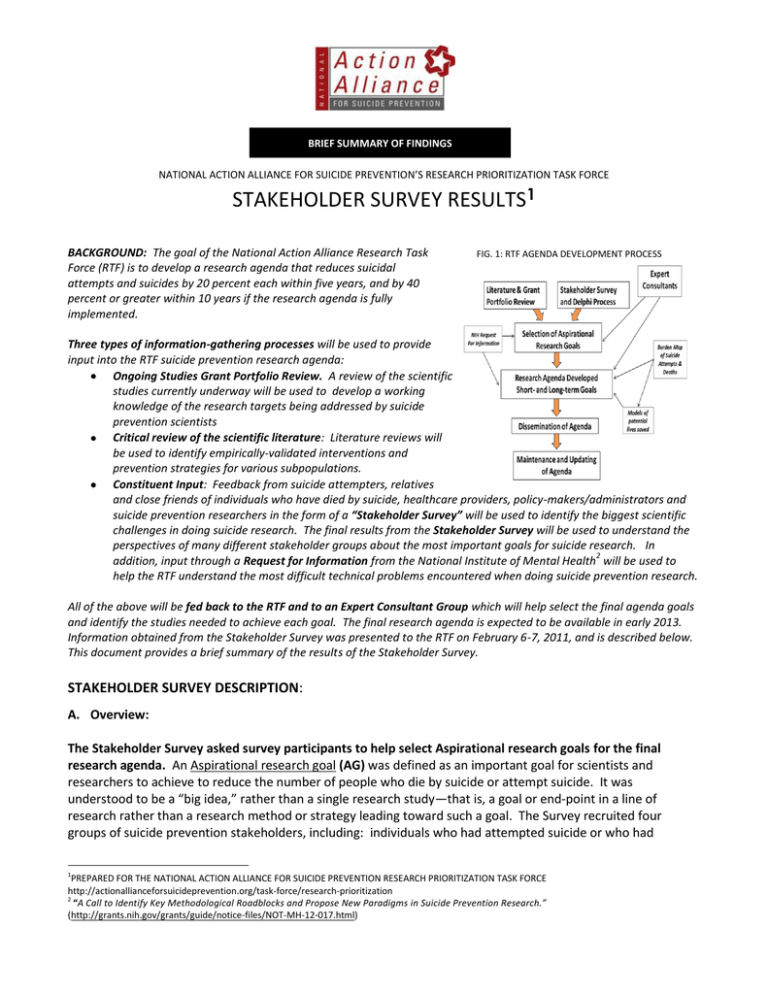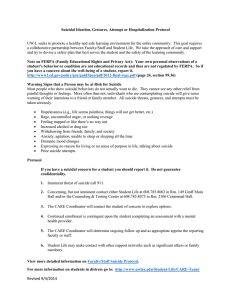STAKEHOLDER SURVEY RESULTS 1
advertisement

BRIEF SUMMARY OF FINDINGS NATIONAL ACTION ALLIANCE FOR SUICIDE PREVENTION’S RESEARCH PRIORITIZATION TASK FORCE STAKEHOLDER SURVEY RESULTS1 BACKGROUND: The goal of the National Action Alliance Research Task Force (RTF) is to develop a research agenda that reduces suicidal attempts and suicides by 20 percent each within five years, and by 40 percent or greater within 10 years if the research agenda is fully implemented. FIG. 1: RTF AGENDA DEVELOPMENT PROCESS Three types of information-gathering processes will be used to provide input into the RTF suicide prevention research agenda: Ongoing Studies Grant Portfolio Review. A review of the scientific studies currently underway will be used to develop a working knowledge of the research targets being addressed by suicide prevention scientists Critical review of the scientific literature: Literature reviews will be used to identify empirically-validated interventions and prevention strategies for various subpopulations. Constituent Input: Feedback from suicide attempters, relatives and close friends of individuals who have died by suicide, healthcare providers, policy-makers/administrators and suicide prevention researchers in the form of a “Stakeholder Survey” will be used to identify the biggest scientific challenges in doing suicide research. The final results from the Stakeholder Survey will be used to understand the perspectives of many different stakeholder groups about the most important goals for suicide research. In 2 addition, input through a Request for Information from the National Institute of Mental Health will be used to help the RTF understand the most difficult technical problems encountered when doing suicide prevention research. All of the above will be fed back to the RTF and to an Expert Consultant Group which will help select the final agenda goals and identify the studies needed to achieve each goal. The final research agenda is expected to be available in early 2013. Information obtained from the Stakeholder Survey was presented to the RTF on February 6-7, 2011, and is described below. This document provides a brief summary of the results of the Stakeholder Survey. STAKEHOLDER SURVEY DESCRIPTION: A. Overview: The Stakeholder Survey asked survey participants to help select Aspirational research goals for the final research agenda. An Aspirational research goal (AG) was defined as an important goal for scientists and researchers to achieve to reduce the number of people who die by suicide or attempt suicide. It was understood to be a “big idea,” rather than a single research study—that is, a goal or end-point in a line of research rather than a research method or strategy leading toward such a goal. The Survey recruited four groups of suicide prevention stakeholders, including: individuals who had attempted suicide or who had 1 PREPARED FOR THE NATIONAL ACTION ALLIANCE FOR SUICIDE PREVENTION RESEARCH PRIORITIZATION TASK FORCE http://actionallianceforsuicideprevention.org/task-force/research-prioritization 2 “A Call to Identify Key Methodological Roadblocks and Propose New Paradigms in Suicide Prevention Research.” (http://grants.nih.gov/grants/guide/notice-files/NOT-MH-12-017.html) RFT Stakeholder Survey April 8, 2012 pg. 2 experienced the suicide of a close friend or relative (i.e., survivors), healthcare providers, policymakers/administrators, and researchers. The Survey involved four rounds of data collection and decision-making, using a process known as the Delphi method (Fig. 2): FIG 2: STAKEHOLDER SURVEY PROCESS An Idea Generating Round asked survey participants to suggest goals for research and identify ways to evaluate the merits of suggested goals. An Initial Ranking and Rating Round asked participants to evaluate a “Short List” of goals taken from the Idea Generating Round. A Feedback and Discussion Round showed participants how their rankings and ratings compared to other participants, and gave them a chance to discuss their opinions with others. A Final Ranking and Rating Round gave participants a chance to change their goal ratings after in the Feedback and Discussion Round. B. Round One (Idea Generating Round): In the Idea Generating Round, more than 1,400 Aspirational Goals were suggested. Using a process that included multiple rounds of categorization of all suggestions,3 the 12 most frequently mentioned goals were identified (called the “Short List AGs”).4 These 12 goals were ranked, rated and discussed in the last three rounds of the Survey. C. Rounds Two - Four (Ranking and Rating Rounds): In the Initial and Final Ranking and Rating Rounds, survey respondents completed two tasks with the 12 Short List AGs. First, they ordered the goals from most to least important overall (goal ranking exercise). Next, they were asked to consider the importance of each of the 12 AGs using four criteria (goal rating exercise). The four criteria were: 1: What is the potential of this goal to prevent fatal and nonfatal suicide attempts? 2: How easily and rapidly can research produced by this goal be widely implemented in real-world settings? 3: How many of the population groups most vulnerable to suicidal behavior would be impacted if this goal were achieved? 4: How acceptable would this goal’s suicide prevention approach be to suicidal persons and their families? D. The Feedback and Discussion Round: As explained above, between the two Ranking and Rating Rounds, participants were shown how their rankings and ratings compared to those of other survey respondents. They were then given a chance to join an online discussion about the importance of each of the 12 Short List AGs. 3 4 The process is described at: http://actionallianceforsuicideprevention.org/system/files/RP_12goals.pdf The 12 goals are described at: http://actionallianceforsuicideprevention.org/system/files/RP_goals.pdf RFT Stakeholder Survey April 8, 2012 pg. 3 E. Who Participated? A total of 716 survey respondents from 49 U.S. states and 18 foreign countries participated in the survey. Of these, 511 respondents participated in the Delphi process (last three rounds). Averages, median scores and weighted median scores (called central tendency measures) were used to identify and describe research preferences by stakeholder group and across the total sample. STAKEHOLDER SURVEY RESULTS: The final results shown in Table 1 are based on ratings data and combine goal into a tiered goal structure. Overall, survey respondents favored research efforts that were practical and results-oriented when rating the goals. 1. The highest-rated Aspirational Goals were grouped and labeled “Tier One”. They were: Goal 9 - Prevent repeat suicide attempts by improving follow-up care after a suicide attempt. Goal 10 - For suicidal individuals, reduce treatment dropout at all stages of the care process by providing better continuity. Goal 3 - To improve the quality of treatment across settings by training healthcare providers and other community-based gatekeepers to identify, intervene, and follow-up appropriately with highrisk individuals. Goal 4 - To design new healthcare delivery strategies to ensure that affordable, accessible, effective care is available to all individuals at risk for TABLE 1: FINAL GOAL RESULTS ORDERED IN TIERS suicidal behavior. TIER 2. A second tier of goals included: TOTAL SAMPLE 1 Goal 9 - Prevention of reattempts Goal 7 - In order to prevent suicide among high-risk individuals and groups, develop widely available, efficient and effective psychosocial interventions targeted at the individual, family, and community levels. 1 Goal 10 - Enhanced continuity of care 1 Goal 3 - Provider and gatekeeper training 1 Goal 4 - Affordable, accessible and effective care 2 Goal 7 - Psychosocial interventions for those at risk 2 Goal 11 - Risk and protective factor interactions 2 Goal 12 - Stigma reduction Goal 11 - Find clear targets for intervention through greater understanding of the interplay among the biological, psychological, and social risk and protective factors associated with suicide. 2 Goal 1 - Population-based risk-reduction/resilience-building 2 Goal 6 - Prediction of imminent risk Goal 8 - Improved biological interventions Goal 2 - Reduction in access to lethal means Goal 5 - Population-based screening Goal 12 - Increase help seeking and referrals for at-risk individuals by decreasing the stigma associated with suicide. Goal 1 - Prevent the emergence of suicidal behavior by developing and delivering the most effective prevention programs to build resilience and reduce risk in broad-based populations. RFT Stakeholder Survey April 8, 2012 pg. 4 Goal 6 - Distinguish suicidal ideation from imminent risk for suicidal behavior by developing and implementing reliable clinical tools. 3. Goals 8 (Improved biological interventions), 2 (Reduction in access to lethal means) and 5 (Populationbased screening) were all ranked somewhat lower, but not all in a way that clustered into one group. 4. Certain stakeholder groups rated some goals in distinct ways, demonstrating the group’s unique perspective on the impact of those suicide prevention goals. For instance, the Survivor group thought that AG12 (Increase help seeking and referrals for at-risk individuals by decreasing the stigma associated with suicide) would be more acceptable (Criterion #4) to suicidal persons and their families (Criterion 4) than did other Stakeholder groups. On Criterion #1 (Impact of a line of research on overall societal burden from suicidal acts), healthcare providers were more enthusiastic about the possible impact of research related to healthcare system enhancements and treatment than were others. The enhancements viewed positively by providers included research on: AG 4 (Affordable and effective care); AG 5 (Population- and setting-based screening); AG 6 (Prediction of imminent risk); AG 7 (Psychosocial interventions for those at risk); and AG 11 (Risk and protective factor interactions). NEXT STEPS: The Research Task Force will provide these findings to a panel of Expert Consultants which will help select the final agenda goals and identify the studies needed to achieve each goal. Additional analyses of the Stakeholder Survey are planned, and other ways of assessing the value of these research goals are underway. Please check the RTF website for future updates. The National Action Alliance’s Research Prioritization Task Force gratefully acknowledges those organizations and individuals who so generously donated their resources, time and expertise in support of the Stakeholder Survey, including: the Jed David Satow Family Foundation, the American Foundation for Suicide Prevention, the American Association of Suicidology, the Suicide Awareness Voices of Education Foundation, Saul Feldman, PhD, the RAND Corporation, and the National Institute of Mental Health. Research oversight of the Stakeholder Survey was provided by the Institutional Review Board of the University of North Texas Health Science Center.




